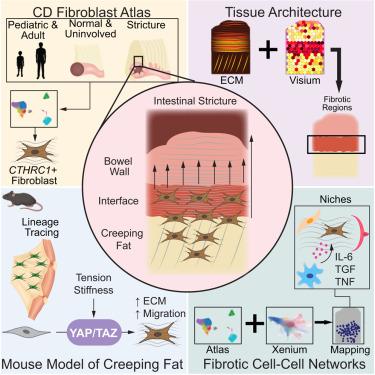Creeping fat-derived mechanosensitive fibroblasts drive intestinal fibrosis in Crohn’s disease strictures
IF 42.5
1区 生物学
Q1 BIOCHEMISTRY & MOLECULAR BIOLOGY
引用次数: 0
Abstract
A significant complication of Crohn’s disease (CD) is intestinal fibrosis, which narrows the bowel lumen to form a stricture. Creeping fat (CF) is the wrapping of mesenteric adipose tissue around diseased bowel, of which the role in CD stricture progression is unclear. By constructing a human single-cell CD fibroblast atlas, we identified CF-derived, CTHRC1+ fibroblasts enriched for Yes-associated protein (YAP)/transcriptional co-activator with PDZ-binding motif (TAZ) signatures and localized to a fibrotic CF-bowel wall interface within the stricture. We further showed that analogous Cthrc1+ mouse fibroblasts derive from mesenteric adipose tissue stromal cells, infiltrate fibrotic bowel, and deposit extracellular matrix in a YAP/TAZ-dependent manner in a mouse model of intestinal fibrosis. Our findings identify CF as a key source of pro-fibrotic fibroblasts and raise the possibility of improving future clinical management of stricture progression by targeting not only the bowel but also CF.

匍匐脂肪来源的机械敏感成纤维细胞驱动克罗恩病狭窄的肠道纤维化
克罗恩病(CD)的一个重要并发症是肠纤维化,它使肠管变窄形成狭窄。蠕动脂肪(CF)是病变肠周围肠系膜脂肪组织的包裹物,其在CD狭窄进展中的作用尚不清楚。通过构建人类单细胞CD成纤维细胞图谱,我们鉴定了cf衍生的CTHRC1+成纤维细胞,这些成纤维细胞富含yes相关蛋白(YAP)/具有pdz结合基序(TAZ)特征的转录共激活因子,并定位于狭窄的纤维化cf -肠壁界面。我们进一步发现,在小鼠肠道纤维化模型中,类似的Cthrc1+小鼠成纤维细胞来源于肠系膜脂肪组织基质细胞,浸润纤维化肠,并以YAP/ taz依赖的方式沉积细胞外基质。我们的研究结果确定CF是促纤维化成纤维细胞的关键来源,并提出了通过不仅针对肠道而且针对CF来改善未来狭窄进展的临床管理的可能性。
本文章由计算机程序翻译,如有差异,请以英文原文为准。
求助全文
约1分钟内获得全文
求助全文
来源期刊

Cell
生物-生化与分子生物学
CiteScore
110.00
自引率
0.80%
发文量
396
审稿时长
2 months
期刊介绍:
Cells is an international, peer-reviewed, open access journal that focuses on cell biology, molecular biology, and biophysics. It is affiliated with several societies, including the Spanish Society for Biochemistry and Molecular Biology (SEBBM), Nordic Autophagy Society (NAS), Spanish Society of Hematology and Hemotherapy (SEHH), and Society for Regenerative Medicine (Russian Federation) (RPO).
The journal publishes research findings of significant importance in various areas of experimental biology, such as cell biology, molecular biology, neuroscience, immunology, virology, microbiology, cancer, human genetics, systems biology, signaling, and disease mechanisms and therapeutics. The primary criterion for considering papers is whether the results contribute to significant conceptual advances or raise thought-provoking questions and hypotheses related to interesting and important biological inquiries.
In addition to primary research articles presented in four formats, Cells also features review and opinion articles in its "leading edge" section, discussing recent research advancements and topics of interest to its wide readership.
 求助内容:
求助内容: 应助结果提醒方式:
应助结果提醒方式:


